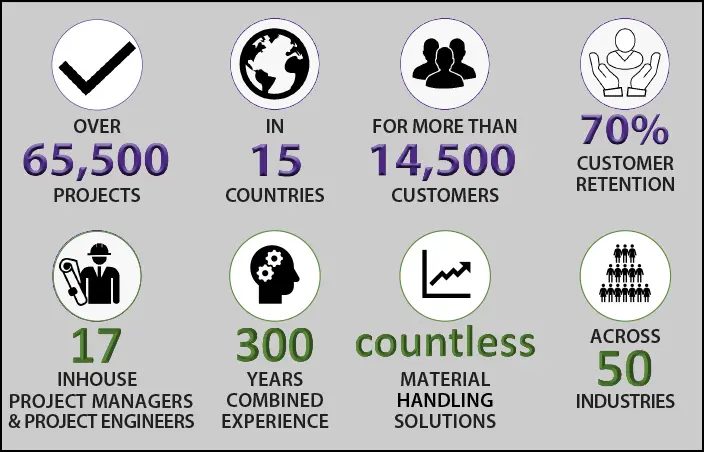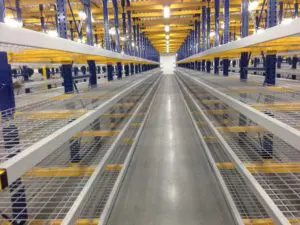Warehouse Clothing Storage: Outfitting Your Operation
Article Updated: 11/21/2023 Back to Blog
Summary:
In this article, we discuss efficient warehouse storage for e-commerce clothing companies. It underscores the importance of organized storage for garment quality and inventory management, enhancing overall efficiency. Selecting the right storage system involves considering garment types, inventory volume, and warehouse layout. It describes three systems: Selective Pallet Racking for easy access but not ideal for hanging garments; Warehouse Catwalk Racking that maximizes vertical space but can be costly; and versatile Cantilever Racking, adaptable for both shelving and hanging garments, offering high density and selectivity in industrial settings.
Introduction to Warehouse Clothing Storage
A well-structured and efficiently managed warehouse is crucial for e-commerce clothing companies. The right storage solutions can enhance operations, minimize costs, and maintain the quality and safety of products. This guide is designed to assist operations managers in identifying the storage needs of their warehouses.
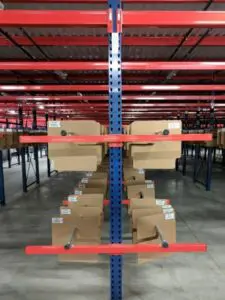
Importance of Organized Clothing Storage
Organized clothing storage ensures garment quality, ease of access, and effective inventory management. It reduces the time and cost associated with handling and shipping products, thus improving overall operational efficiency.
Proven Storage Solutions for a Clothing Warehouse
Choosing the Right Type of Storage System & Picking Solution
The selection of an appropriate storage system and picking solution is a critical decision that necessitates a tailored approach, taking into account the specific requirements and nuances of your operation. There are a few key considerations in this decision-making process. First, the nature of the garments – are they hanging, folded etc. – as each type necessitates a different storage solution.
Additionally, the volume of inventory must be carefully assessed to ensure that the chosen system can adequately accommodate the scale of your operations. The dimensions and layout of the warehouse space itself also play an integral role in determining the most suitable storage system. By conducting a thorough evaluation of these vital factors, you can ensure that your chosen solution not only aligns with but also enhances the efficiency and organization of your warehouse, ultimately contributing to the smooth and successful functioning of your e-commerce clothing business.
Below we’ve outlined a few of the most common warehouse clothing storage solutions.
Selective Pallet Racking System
In the garment industry, selective racking systems play a crucial role in optimizing storage and accessibility. Similar to the most common type of racking system, selective racks allow for direct access to garments placed on pallets or in cartons, without the need to move others. This streamlined approach provides a highly selective solution to meet the unique demands of fashion inventory management.
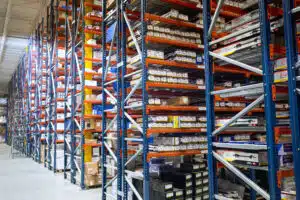
Pros:
- Provides easy access to all items, which can be beneficial when you need to pick specific garments or styles quickly.
- Can be adjusted and configured to accommodate different garment sizes and packaging types.
- Often a more affordable option compared to automated systems or specialized garment racking.
- Additional racks can easily be added to accommodate more clothing.
Cons:
- May not be the most space-efficient option, as there needs to be aisles between racks for forklift access. This can result in wasted space, which might be better utilized with other racking systems.
- Not designed for hanging garments.
Warehouse Catwalk Racking Systems:
Warehouse catwalk systems involve creating a multi-level catwalk system that can be used for hanging garments. It maximizes vertical space and provides easy access to garments.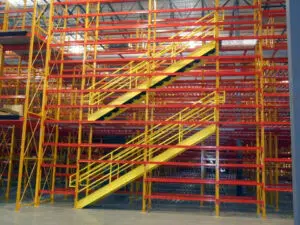
Pros:
- Maximizes vertical space.
- Allows for easy access to garments.
- Can be customized to fit specific needs.
Cons:
- Can be expensive to install.
- May require significant modification to existing warehouse layout.
Cantilever Racking Systems:
Cantilever racking systems are known for storing long or bulky items such as piping, sheet metal, and lumber. However, there are two ways in which cantilever rack can be designed as an ideal storage solution for clothing.
Add Wire Deck for Hand Picking
Outfitting a cantilever rack with wire decking is as simple as placing the wire deck onto the arm supports. The uprights are flipped 90 degrees, so they go down-aisle instead of cross-aisle. The addition of the wire decking creates a continuous shelf with no frontal obstructions that allow for items varying in weight to be placed anywhere onto the system.
Cantilever rack with wire decking differs from selective rack because there are no vertical obstructions from frames, resulting in higher selectivity, density, and space utilization. With no vertical obstructions from the uprights, the wire decking spans the entire length of the row. This means extra space for you to store on and higher visibility for pickers.
Add Rails for Hanging
Rails can be added across the cantilever arms to support garment hangers. This can be a high-density, heavier-duty solution for hanging apparel in industrial type environments such as those found in e-commerce storage and distribution. In this solution, the cantilever arms are set up the same way as with the wire deck. The rails are secured to the arms for the secure storage of apparel.
Pros:
- Because there are no vertical obstructions from frames, the wire decking spans the entire length of the row. This allows for more items to be stored while maintaining high selectivity.
- Arms can be adjusted to accommodate different item sizes and weights. For example, below is a picture of one warehouse system using wire decking. This can be a high-density, heavier-duty solution for apparel in industrial type environments such as found in e-commerce storage and distribution.
- Easy Access: Items are easily accessible, facilitating efficient picking and inventory management.
Read more about this successful Cantilever Racking System Case Study
Cons:
- Depending on the height of your warehouse and the design of the cantilever racks, you may be limited in how high you can store items.
Pick-to-Light System:
In a pick-to-light system, lights and alphanumeric displays guide the picker to the correct location and indicate the quantity to pick. This can be an effective option for folded garments as it provides clear visual cues, reducing the risk of errors.
Pros:
- Increases picking accuracy by providing clear visual instructions.
- Can be easily adapted to different order sizes and volumes.
- Reduces the risk of items becoming unfolded or wrinkled during the picking process.
Cons:
- High initial investment in technology and equipment.
- Requires regular maintenance and potential repairs if any of the lights or sensors fail.
Talk to one of our material handling conveyor designers & engineers today
Picking Methods for Hanging & Folded Garments
When dealing with garments in a warehouse, it’s important to have a picking system that maximizes efficiency while minimizing potential damage to the clothing. Here are three picking methods that can be effective for folded garments:
1. Zone Picking:
In zone picking, the warehouse is divided into different zones, and each picker is responsible for picking items from a specific zone. This can be especially effective for folded garments as it minimizes the handling of each item.
Pros:
- Increases picking efficiency by reducing travel time for pickers.
- Can be easily adapted to the specific layout of a clothing warehouse.
- Reduces the risk of items becoming unfolded or wrinkled during the picking process.
Cons:
- Can be less efficient if not properly managed and coordinated.
- May require additional technology or equipment to manage and track picks.
2. Batch Picking:
In batch picking, multiple orders are grouped together and picked at the same time. This can be a good option for folded garments as it allows for the efficient picking of multiple items at once.
Pros:
- Increases picking efficiency by reducing the number of trips to the same location.
- Can be easily adapted to different order sizes and volumes.
- Reduces the risk of items becoming unfolded or wrinkled during the picking process.
Cons:
- Requires careful planning and organization to group orders effectively.
- May require additional technology or equipment to manage and track picks.
3. Pick-and-Sort System:
Picked items are sorted into order-specific containers or areas. This is especially effective for hanging garments, as it ensures that each order is complete and ready for delivery.
Pros:
- Increases efficiency by reducing the time needed for sorting and packing.
- Ensures that orders are complete and accurate.
- Can be easily adapted to different order sizes and volumes.
Cons:
- Can require additional space for sorting areas.
- May require additional technology or equipment to manage and track orders.
- Can be less efficient if not properly managed and coordinated.
Environmental Impact of Garment Storage
Sustainable Storage Practices
Implementing sustainable storage practices, such as optimizing space, using eco-friendly materials, and employing energy-efficient systems, can significantly minimize the environmental impact of a warehouse.
Reducing Waste in Garment Warehouses
Reducing waste involves recycling packaging materials, repurposing defective garments, and minimizing the use of non-recyclable materials.
Planning and Designing a Warehouse Clothing Storage
Assessing Warehouse Space
When planning the storage layout for a clothing warehouse, it’s crucial to meticulously assess the available space. Important factors to consider include ceiling height, floor space, and any physical obstacles that may impede storage or access. Additionally, for clothing warehouses, the type of flooring is also essential, as it should be able to support the weight of racking systems and any machinery used, such as forklifts, without causing damage to the garments.
Establishing Storage Requirements
In the clothing industry, different types of garments may require different storage conditions. Consider the types and volumes of garments to be stored, along with any specific storage conditions required, such as temperature or humidity control. For instance, leather and fur items may require temperature-controlled environments to prevent damage. Furthermore, the volume of inventory will also dictate the size and type of storage solution needed.
Incorporating Efficient Warehouse Design
An efficient warehouse design is crucial for maximizing storage space and streamlining the picking process, particularly in the fast-paced clothing industry. Space-saving solutions such as mezzanine floors and multi-level racking systems should be considered. Additionally, incorporating conveyor belts or automated sorting systems can further enhance efficiency and accuracy in order handling and fulfillment.
Importance of Layout in Clothing Storage
The layout of the clothing warehouse should be meticulously designed to minimize the distance and time required for each step of the process, from receiving to storage to shipping. Aisles should be wide enough to accommodate any machinery used, and racks should be organized in a way that allows easy access to popular or seasonal items.
Safety Measures in Warehouse Clothing Storage
Safety Standards and Protocols
Adherence to safety standards and protocols is paramount in a clothing warehouse, just as in any other. Regular safety audits, comprehensive staff training, and the use of appropriate safety equipment, such as hard hats and safety shoes, are essential. All machinery and equipment should be regularly inspected and maintained to prevent accidents.
Handling and Storage Procedures
Proper handling and storage procedures are critical in preventing garment damage and ensuring the safety of warehouse staff. Consider using specialized hangers, garment bags, and other protective measures to preserve the quality of the clothing. Additionally, proper training on handling and lifting techniques will prevent injuries among warehouse staff.
Emergency Response Plans
An emergency response plan should be in place to address potential disasters, such as fire or flood. This includes clearly defined evacuation procedures, readily accessible emergency contact information, and measures to protect garments and equipment from damage. For instance, fire-resistant garment bags and water-tight storage containers can be used to safeguard the inventory.
Learn More
To read more e-commerce storage solutions visit REB’s e-commerce industry page.
Let’s Connect
REB has been providing material handling systems to the warehousing and distribution industry since 1962. We understand that your storage system should maximize efficiency. Our team of engineers specializes in evaluating and designing a storage system based on your specific inventory characteristics, giving you a system that optimizes your operation.
Fill out the ‘Submit Your Inquiry’ form to get in touch with one of our industry experts who can answer any questions you may have regarding cantilever rack wire decking applications.
Share this post:
Submit Your Inquiry
Testimonials
Blog Topics By Category
Blog Topics By Industry
